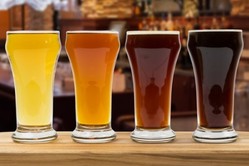The marriage of high tech mass isotope ratio mass spectrometry (IRMS) analysis with the West Country’s traditional tipple is ensuring that cider drinkers the world over are enjoying a better quality of product, writes Dr. Richard Sleeman.

Cider is a way of life in the South West of England. Apples have been grown in the area for at least a thousand years with the first mention of cider presses as a source of income appearing in a Royal Charter granted to the Bishop of Bath in 1230.
In fact, the UK has been producing the apple-based tipple for far longer than that with the first recorded reference to cider dating back to Ancient Roman times. During Julius Caesar’s invasion of Britain in 55BC, the Roman legions discovered Ancient Britons fermenting crab apples. They liked the idea so much that they brought the concept back to Rome where the drink soon spread around the rest of the Empire. In the Middle Ages cider was used to baptise children, pay farm labourer’s wages and was even mentioned in a 15th Century
bible.
Although firmly rooted in ancient tradition, the love affair with cider is currently blossoming. The market has witnessed significant growth in recent years, with global sales reaching over 2 billion litres in 2013. The UK has always been the world’s largest cider market. Worth approximately £3bn annually - and supporting around 9,000 rural jobs - that figure is
predicted to swell to £3.7bn by 2017. This increase partly stems from new marketing-led trends like fruit flavoured ciders and partly due to customers adopting cider as a sweeter alternative to beer.
"Cider enjoys a much more even gender split than any other category [of alcoholic drink]," says Simon Russell, spokesman for the National Association of Cider Makers. "It is enjoyed equally by men and women, as well as a broad demographic in terms of age."
Following the current trend for craft beers and keen to position themselves on a similar premium platform, large producers have recently started to brand their ciders as pseudo
‘craft’ drinks. Craft drinks are smaller runs of product which usually sell on the unique fact that they are handcrafted by a smaller brewery, eschewing the larger corporations. Still, as this marketing tool has become more prominent in the industry, ciders and perries have been attracting a wider audience than ever before.
As a result,
industrial producers such as Gaymers, Bulmers, Koppaberg and Merrydown have weathered the economic downturn relatively well against a background of
declining beer sales. But it’s not just the main players who are feeling the benefit - smaller producers are also thriving and multiplying in the boom. Figures differ but there are now somewhere between 300 and 500 small scale producers operating in the UK. What is central to these small independent producers such as traditional cider producers like Frank Nash in West Pennard, whose family have been fermenting apples for almost 200 years, to recent start-ups like Orchard Pig near Glastonbury, is a focus on quality and authenticity.
While the number of producers is multiplying, there is also an explosion of variety within the market - flavoured ciders, different casks, experimentation with apple varieties. The appreciation of apples is becoming a lot more serious than ever before and the industry is trying to keep pace.
"Cider brand owners are aware that the average cider drinker is growing up and experimenting with other new styles of drink,"
writes Jessica Mason in the
Morning Advertiser. "Cue a series of new flavour variants and stylish packaging updates with nods to provenance, traceability and heritage, all of which are designed to appeal to a slightly more conscientious consumer."
To keep up with the demand for more imaginative, stronger ciders,
some manufacturers are taking liberties by using chaptalisation to manage the alcoholic strength of their drinks. Chaptalisation is the practice of adding sugar (usually in the form of cane sugar or corn syrup) to fermentation in order to increase the alcoholic strength of an alcoholic drink. Many countries have regulations dictating the maximum levels of sugars that can be added to drinks at this stage.
As well as breaking regulations, there is also a health factor to
chaptalisation, in that it can affect people with an intolerance to certain sugars - another reason why knowing precisely how the cider was fermented is important to consumers who wish to make informed drinking choices.
Increased choice and savvier customers means an increased emphasis on quality as a differentiating factor between brands. Adding sugar to the fermentation process undermines this authenticity, an authenticity which is key for the industry to establish and maintain the highest standards.
It is against this background that mass spec has begun employing new testing methods to prove the provenance of cider products faster and with greater resolution than previously thought possible.
Isotope ratio mass spectrometry (IRMS) can reveal how much alcohol in a drink comes from the fermentation of added cane or corn derived sugars as opposed to sugars naturally present before fermentation (e.g. grape, apple, wheat, barley and other fruit derived sugars).
This technique distinguishes between samples of chemically identical material based on the differences in the number of neutrons in the nuclei of the atoms making up a substance. The stable isotopic composition of ethanol can be indicative of its source.
There are two main biochemical pathways used by plants to convert CO2 (carbon dioxide) from the atmosphere into sugars. Corn and cane are known as C4 plants, whilst the others, like grapes, are known as C3 plants. These different biochemical pathways give rise to isotopic differences, which are over and above the normal geographical or climatic differences, and are very easy to spot.
What this ultimately means is that if anyone were to increase the alcohol value - or chaptalise - an alcoholic drink using cane sugar or corn syrup it would, at an atomic level at least, raise alarm bells as to its production method.
Unlike other techniques employed for this type of analysis, mass spec measures only the isotope ratio of the ethanol in the sample and requires no distillation steps, thereby eliminating interference from other compounds in the samples and drastically reducing any potential isotopic fractionation during the analysis. This provides a fast, reliable and cost-effective means of detecting sugar addition pre-fermentation.
This technique offers increased protection to the consumer, ensuring that producers are accurately describing the provenance of their ciders and offering a more informed choice for those to whom quality is an important factor. On the production side it also works as a form of brand protection.
With so many large producers keen to position their products in the ‘craft’ section of the market, the ability of small- or medium-sized cider makers to prove the provenance of their product and show its traceability, traditional techniques and heritage enables them to differentiate themselves from their larger counterparts in what is a varied and flourishing market.

Dr. Richard Sleeman is scientific director of Mass Spec Analytical Ltd. More information on IRMS and its application in the food & beverage sector is available at service@msaltd.co.uk.
©
SecuringIndustry.com




 Cider is a way of life in the South West of England. Apples have been grown in the area for at least a thousand years with the first mention of cider presses as a source of income appearing in a Royal Charter granted to the Bishop of Bath in 1230.
Cider is a way of life in the South West of England. Apples have been grown in the area for at least a thousand years with the first mention of cider presses as a source of income appearing in a Royal Charter granted to the Bishop of Bath in 1230.
